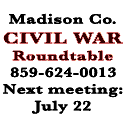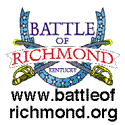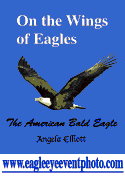|
Battle of Richmond, Cleburne promoted
development of sharpshooter tactics
By ROBERT C. MOODY
(EDITOR’S NOTE: Robert Moody is a Battle of Richmond historian and a specialist on Civil War history. His article on sharpshooters has been condensed to meet space requirements.)
The origin of the term “sharpshooter” is somewhat clouded.
A common misconception is that the term came from the Civil War sharpshooter units who were equipped with the Sharp’s rifles. Sharpshooter techniques, however, were employed by guerillas during the Revolutionary War. Later, the term was used in early nineteenth-century military records describing the tactics of skilled marksmen firing from concealment and at long range.
Sharpshooter units first were organized by the Union army. Col. Hiram Berdan, himself an excellent shot, was responsible for recruiting two sharpshooter regiments. His 1861 recruiting poster, directed at the adventurous in Utica, N.Y., proclaimed:
“Many are called, but few are chosen.” This Company consists of gentlemanly men –
none other need apply – as it is the ‘Crack Regiment’ in the service. Our wages are
higher than any other company’s! As many furnish their own Rifles, but the
Government supplies each man with one of Berdan’s Improved Sharp’s Rifle, which
will fire 1 1⁄4 mile at the rate of 18 times per minute. We have no drill but Skirmish
Drill, no Picket duty; our manner of warfare is like the “Guerillas” or Indian. Our
uniform is ‘Green’ for summer, color of the grass and foliage, and ‘Miller’s Grey’ for
fall and winter. Your are privileged to lay upon the ground while shooting, picking
your position; no commanders while fighting. I will pay board and traveling
expenses as soon as enlisted.
For enlisting, a recruit received a $100 bounty, a land warrant and other amenities. No self-respecting New Yorker could turn his back on such an offer. The lack of officer supervision particularly was attractive to recruits.
Union sharpshooters were used throughout the Civil War, but no record exists of their having had a decisive effect on a battle. Also, there is no evidence for the assertion that Union sharpshooters were more effective in picking off opposing officers on horseback than were other infantrymen. After the war, a company of sharpshooters was retained in the U.S. Army.
On the Confederate side, things were different. After the Confederate defeat at Shiloh, April 6-7, 1862, Brig. Gen. Patrick R. Cleburne determined that if the Confederates were to be successful in future battles, tactical changes were necessary. The standard Napoleonic tactics of meeting massed forces with other massed forces were employed at Shiloh. But, because of the Federal superiority in manpower and material, Cleburne concluded that Napoleonic tactics would no longer work.
Those tactics called for small arms to be discharged toward the mass of the enemy, with little or no emphasis on aiming. No consideration was given to fire and maneuver.
Clearly, a change in small unit tactics was indicated.
Gen. Cleburne, after consulting with his regimental commanders, detached from each company five soldiers, known to be good marksmen, and organized them into separate sharpshooter companies. Contests were held to select the best shots, and, after formation, the new units trained and drilled separately.
Special sharpshooter equipment and weapons, however, were not available early in the war and it was not until 1863 that Cleburne’s sharpshooters were equipped with scoped Whitworth rifles.
These very expensive weapons were imported from England and used special ammunition. And, their introduction greatly improved sharpshooter efficiency.
When the Confederate army precipitated the 1862 Battle of Richmond at the village of Kingston the morning of Aug. 30, Cleburne had two operational sharpshooter companies.
He used the company from the consolidated 13th-15th Arkansas Regiment as skirmishers to locate the Federals on the east side of the Old State Road. That company was effective in causing a subsequent Union panic.
He sent the other sharpshooter company to a position near Kavanaugh Armstrong’s home, later known as Pleasant View.
From there, the marksmen fired on and scattered the Union battery situated on the Old State Road southeast of Mt. Zion Church. This added to the Union panic and hurried withdrawal.
Later, sharpshooters acquired special equipment. Field glasses and telescopes were made available and special firearms with full-length scopes were utilized. The unusually bright green uniforms of the Union sharpshooters set them apart as being especially skilled. Some adopted special hat insignia consisting of an upright musical horn.
The Confederate sharpshooters were set apart not by a different uniform, but by their Whitworth rifles, which could kill at 1,700 yards.
After Shiloh, Gen. Cleburne realized that sharpshooters multiplied the effect one soldier could have on a battle. His selected use of sharpshooters on both ends of his lines at Kingston was the first such use of skilled Confederate marksmen in the western theater.
And, perhaps, even in both theaters.
|











